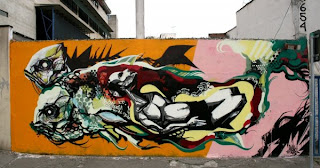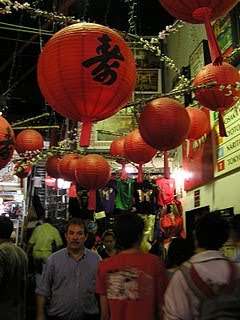the Liberdade, the Japanese district of São Paulo: Among Japanese and their descendants, more than 1 million of people of Japan in Sao Paulo. They are the world's largest Japanese community outside Japan. Still you find old people who do not speak Portuguese. It is a very traditional community, which only recently has broken taboos and has begun to marry non-Japanese.
The influence of Japanese culture in the life of São Paulo is huge. Its highest expression is probably the kitchen, not in vain we have more than 650 Japanese restaurants. The ingredients for Japanese food found in supermarkets, and in many neighborhoods, including mine, there is a store of Japanese products. In the neighborhood of Liberdade, of course, is where the largest supply of products. Every time I visit back home loaded with all kinds of Japanese food.
contains the largest Japanese population (immigrants and descendants) outside of Japan. There are also other ethnic groups (mainly Asian) present in Liberdade, including Chinese (both mainland China and Taiwan) and Korean. The district has access to the São Paulo Metro and several bus lines, is located near the historical center of São Paulo and Avenida Paulista
Some Japanese words have entered the lexicon Portuguese Japanese children are known as nisseis. The children of nisseis, are known as sanseis. And the sanseis nisseis or going to work in factories in Japan for a while to save money and then return to Brazil are known as decasséguis.
 Only in a city the size of São Paulo, more than one million inhabitants that make up the Japanese community could be considered minority. And indeed restaurants of sukiyaki, shiatsu massage and markets are concentrated in the neighborhood of Liberdade, definitely a must for minimally curious palates and noses.
Only in a city the size of São Paulo, more than one million inhabitants that make up the Japanese community could be considered minority. And indeed restaurants of sukiyaki, shiatsu massage and markets are concentrated in the neighborhood of Liberdade, definitely a must for minimally curious palates and noses. What country outside of Japan, any person, regardless of social class or culinary curiosity, you know what a yakisoba or temaki? Only Brazil, where the Japanese community, the world's largest outside Japan, is about to reach, between natives and descendants, a million and half people. Most of them are concentrated in São Paulo, where the community made this neighborhood their maximum reference Liberdade.
Anyone passing through São Paulo can forget for a day is a tropical country, and reserve a few hours for a shiatsu massage, a good traditional Japanese food, a show of taiko or a radio show taissô, oldies by Nipponese. And all walking under the red lamps suzuranto typical of Japan, which illuminate the streets of Liberdade.
For those who do not speak Portuguese or Japanese, it is sometimes difficult to be understood traders or residents. But anyone who has been in the Chinatowns of San Francisco or New York will be surprised at how the famous Brazilian warmth pervaded the eastern and locals who will have much patience for tourists.
 But Liberdade is not a "museum district": Located in the heart of São Paulo, visitors get lost in it among Brazilians, Eastern and descendants, the whole world of shopping or looking for a service that can only be found here. I, for example, I go to the neighborhood whenever I need to buy good pots and pans, or find fresh shitake mushrooms and wasabi. Over time, the neighborhood was no longer exclusively Japanese and went to get Chinese and Korean immigrants. But there is still the Japanese community, which in 2008 completed one hundred years in Brazil.
But Liberdade is not a "museum district": Located in the heart of São Paulo, visitors get lost in it among Brazilians, Eastern and descendants, the whole world of shopping or looking for a service that can only be found here. I, for example, I go to the neighborhood whenever I need to buy good pots and pans, or find fresh shitake mushrooms and wasabi. Over time, the neighborhood was no longer exclusively Japanese and went to get Chinese and Korean immigrants. But there is still the Japanese community, which in 2008 completed one hundred years in Brazil. who come to São Paulo with the need to be near the center can stay here and make for an immersion in the local Japanese community. There should be about 30 Japanese restaurants within 500 meters from the hotel.
the Liberdade district is about 20 blocks, but the streets that concentrate shops and interesting places to visit are Rua Galvão Bueno, Rua da Gloria, and Rua Conselheiro Furtado dos Estudantes. And of course, squares Liberdade and Almeida Junior.
With a tiny radio, such as those that were heard in football matches, rádio taissô began in Japan in 1928. She put the unit on the floor in a square, and the music danced out of there, taking advantage of exercising every step. It became a practice, a discipline that combines gymnastics and dance. For early risers: every day, at 6:30 in the morning, together about 90 people, most of them east, in Liberdade Square. "Practice is for all ages and no contraindications. There are 22 minutes of rhythmic exercises, basically stretching, twisting and some hops, divided in 26 movements, "To participate is to come and join, you do not register.
Go to the neighborhood of Liberdade is a good opportunity to get a shiatsu massage, the most widespread style in Brazil by the Japanese community, "or reflexology, a therapeutic massage on the feet. They are found in markets or in small towns commercial, crowded with people. Or any place where you see the word massagem and a lot of Japanese ideographs.
in Japanese rural villages said that the size of the place was not given only by geographical boundaries but also by how far I could hear the drum. Taiko is the ceremony during which he played the tsuzumi, or drums. Busshin-ji Temple has information about the demonstrations.
Here are some of the most picturesque markets: Marutaka (Rua dos Estudantes 46), Hime-ya (Rua Galvão Bueno 54) and Well House (Rua Galvão Bueno 48). Entering the little markets Oriental Liberdade is a bane. There are so many things one had ever seen: fruits and vegetables, canned juices and cooking equipment for use indecipherable. Everything is imported from Asia and get the freshest, but also the Japanese community that spans several rural regions of São Paulo provides fruit and vegetables commonly consumed in Japan. An example is the longan, a fruit the size of a plum girl, inside is like a grape. There are also tea, rice, shitake mushrooms, shimeji, jelly beans, ginger, a kind of cucumber called nigauri. In short, unless you have had a good time in Asia, most products are unknown. It is best to ask a Japanese lady who is buying what's what. Or, get lost on shelves, all aligned to make every space horizontally and vertically, and expose as many products as possible: trays of sushi, fresh oysters, geisha statues, fans, dragons, lamps, pots and kettles .
Some of the little markets are small, some just seem lost in corners add strength conquered neighboring houses, it is sometimes possible to find a chair waiting for massage to a customer. All these markets are indoors, and if not because the products are Asian, would seem to any neighborhood flea market a few decades ago. Do not be surprised: some of the little markets are served by Chinese Japanese. The villages do not have much sympathy, but business is business.
need not be one of the 300 million followers of Buddhism in the world to visit Busshin-ji Temple, the Soto Buddhist Community Zenshu. Its architecture is very attractive, and the place is total peace of mind to take a break between a walk and another.
in Liberdade, named in honor the black slaves who lived in the region, too many places to eat. From traditional, attended by Japanese who still speak Portuguese with difficulty, to the more Westernized. Both the quality is guaranteed because, in an eastern neighborhood in eastern diners, no restauranteur Japan risks his honor. By having so many restaurants in just two blocks away, Rua Tomaz Gonzaga is known as aji no Suzuran dori Street flavor. But it is not unique.
The Gombe is one of the most traditional restaurants in Liberdade. His specialty is fish and grilled vegetables. It is highly recommended the albacore and the cone-shaped temaki by seaweed and rice with sea urchin, which is fashionable among those who appreciate Japanese food. The chef of the place, Alexandre Oyama, said another favorite dish of the Eastern community is udong-rice noodles.
The atmosphere of the place is one of the most traditional of Liberdade: solid wood tables, wood paneled walls, lamps, round, white, and held various spaces, with low tables, eating barefoot on mats.
Two metro stop in Liberdade, the eponymous Liberdade, São Joaquim. The first is in the Plaza Liberdade. It can also be easily reached by taxi from any part of the city. About 20 minutes by taxi costs about $ 10.
Feira da Liberdade, the two hectic days in Liberdade are Saturday and Sunday. On Saturday, people go shopping. Sunday is the traditional day, because it is when does the fair Liberdade. Begins at 9 am and remains open until sunset in the Plaza Liberdade, which was recently remodeled as one of the preparations for the centennial of the Japanese presence in the country, which falls in 2008. If you've never been to Asia, you have never seen so many people of oriental origin Board and in this place. There are Japanese bamboo handicrafts, silk, traditional food-like rice cake, mochitsuki-therapeutic products and lots of imported goodies, and smuggled-in Asia.


























0 comments:
Post a Comment